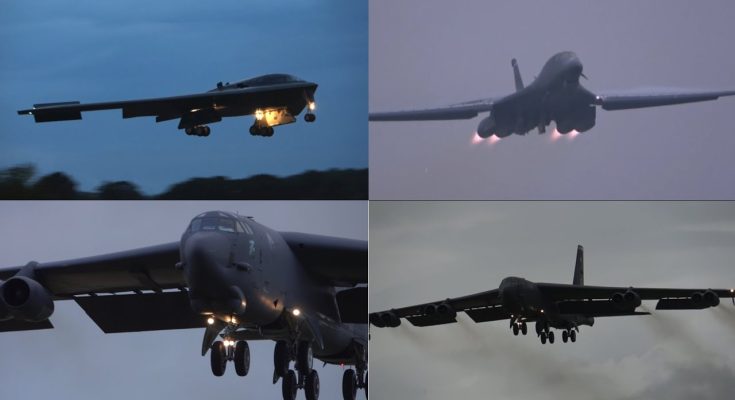The U.S. Air Force’s presence at RAF Fairford, located in Gloucestershire, England, represents a significant display of American military strength and a strategic partnership with the United Kingdom. RAF Fairford is one of the few airbases in Europe that has been used by the U.S. for long-range bomber operations, and it serves as a critical asset for global power projection, especially when deployed in support of NATO operations or in response to emerging threats. When bombers such as the B-1 Lancer, B-2 Spirit, and B-52 Stratofortress are stationed at Fairford, it serves as both a deterrent to adversaries and a demonstration of the U.S.’s ability to respond rapidly to any global crisis.
Strategic Significance of RAF Fairford
RAF Fairford’s strategic location in the heart of Europe allows U.S. forces to deploy quickly to the continent and operate within a critical geographic area. Situated relatively close to Russia and other geopolitical flashpoints, the airbase plays a pivotal role in maintaining stability and deterrence in Europe and beyond. Its long runways, large aircraft parking spaces, and ability to accommodate heavy bombers make it a valuable asset for the U.S. Air Force’s bomber fleet.
In times of heightened tensions, bombers like the B-1, B-2, and B-52 are regularly rotated through Fairford as part of both routine exercises and more urgent deployment schedules. These bombers, which form the backbone of U.S. strategic bombing capabilities, are essential for deterrence, long-range strikes, and global rapid-response operations.
B-1 Lancer: The Backbone of Conventional Strike
The B-1 Lancer, often referred to as the “Bone,” is a versatile supersonic bomber designed for long-range conventional strike missions. With its variable-sweep wing design, the B-1 is capable of flying at high speeds while carrying a significant payload of bombs and precision-guided munitions. The aircraft is primarily tasked with conventional bombing operations, including strategic and tactical missions that require high-speed penetration of enemy airspace.
At RAF Fairford, the B-1 is often deployed for training exercises and demonstrations of power projection. Its ability to carry a diverse range of munitions, from conventional bombs to precision-guided munitions, makes it a critical asset for the U.S. in both deterrent and combat roles. The B-1 can quickly reach any region, respond to emerging threats, and support NATO’s strategic objectives in Europe.
B-2 Spirit: Stealth and Precision
The B-2 Spirit, with its distinctive flying wing design, represents the U.S. Air Force’s most advanced stealth bomber. Capable of carrying both conventional and nuclear payloads, the B-2 is designed to penetrate heavily defended airspace and deliver precision strikes with little to no detection by enemy radar. This makes it an invaluable tool for high-stakes missions, such as striking heavily defended targets or conducting precision strikes in contested areas.
When the B-2 is stationed at RAF Fairford, it sends a powerful message about the U.S. Air Force’s ability to strike anywhere, anytime, with virtually no warning to adversaries. Its stealth technology makes it nearly invisible to enemy radar, ensuring that it can accomplish missions with unparalleled precision and minimal risk of detection. For NATO allies, the presence of the B-2 at Fairford reinforces the concept of nuclear deterrence, showcasing the ability to deliver strategic strikes in the event of an escalated conflict.
B-52 Stratofortress: Enduring Power
The B-52 Stratofortress, the oldest of the three bombers, has been in service for more than 60 years. Despite its age, the B-52 remains a workhorse for the U.S. Air Force due to its massive payload capacity and ability to conduct both strategic and tactical bombing missions. The B-52 can carry a wide range of munitions, including conventional bombs, cruise missiles, and nuclear weapons.
At RAF Fairford, the B-52’s role often involves long-range bombing exercises, maritime patrols, and integration with NATO forces. Its presence in Europe demonstrates the U.S. commitment to its allies and highlights the long-range power projection capabilities of the American military. The B-52 is a symbol of the U.S. Air Force’s enduring reach and flexibility in delivering both conventional and nuclear deterrence.
Conclusion: Deterrence and Readiness
The deployment of the B-1, B-2, and B-52 bombers at RAF Fairford serves as a clear demonstration of U.S. military power and commitment to its European allies. These bombers, each with its unique capabilities, play a critical role in maintaining air superiority, nuclear deterrence, and global stability. By staging these advanced aircraft at Fairford, the U.S. ensures that it can respond rapidly to emerging threats and support NATO operations anywhere in Europe or beyond.
RAF Fairford’s strategic importance, combined with the versatility of these bombers, underscores the U.S. Air Force’s ability to project power globally. Whether participating in joint training exercises, conducting strategic deterrence missions, or responding to regional conflicts, the presence of the B-1, B-2, and B-52 at RAF Fairford serves as a constant reminder of American military readiness and the strength of its global alliances.



